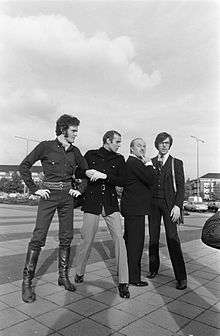Tom Gilbey (designer)
| Tom Gilbey | |
|---|---|
 Sighsten Herrgård, Tom Gilbey, Jacques Esterel and Frans Molenaar (1969) | |
| Born |
Tom Gilbey 19 May 1939 London, England |
| Residence | London, England |
| Nationality | British |
| Occupation | Fashion designer |
Tom Gilbey (born 19 May 1939) is a British fashion designer associated with Savile Row tailoring of the 1960s. His designs have featured in the Fashion Museum, Bath, and are in the collections of the Victoria & Albert Museum and the Museum of London.
Early life
Tom Gilbey was born in London. He left school at the age of fifteen.[1]
Career
Gilbey entered the fashion industry in the 1960s. Speaking about new entrants to the Savile Row area then, Gilbey commented in The Independent, "You had Tommy Nutter, Rupert Lycett Green, Michael Fish and myself ... Tommy Nutter wasn't a tailor and a cutter. He came from the sales side."[2]
Putting down an early marker as to his design philosophy in the 1967 book by Rodney Bennett-England, entitled Dress Optional; the revolution in menswear,[3] Gilbey says "More people than ever are working, and harder too. They want clothes they can put on and forget about, but clothes that nevertheless look right and help them do the job. Such clothes must have ease of movement, easy-care properties, accent on design simplicity."
A 1968 suit of his is in the collection of the Victoria & Albert Museum, which writes of it, "Worn with a silk rollneck shirt , this suit exemplifies the informal dress codes of the later 1960s. The revolutionary idea of replacing the shirt and tie reached even to Savile Row establishments. Gilbey uses a traditional tweed for a futuristic design, incorporating zipped front and pocket fastenings.".[1]
A 1969 suit in the Museum of London comes from Gilbey's shop in Sackville Street, where it required four fittings. It was made to be worn on a Queen Elizabeth II sailing from New York to Southampton on 8 October 1969, for dinner at the captain's table - "The wearer later regretted his choice, which looked totally out of place at a formal occasion where dinner jackets were the norm."[4]
In the early 1970s, the snooker player Alex Higgins wore a Gilbey outfit whilst playing a match in a packed hall in Bombay. In high temperatures without air conditioning, Higgins found it unsuitable, and "sweated off another eight ounces in weight" with every ball he hit.[5]
In 1995 one of his bridegroom's outfits was chosen, along with a Catherine Rayner wedding gown, to represent the Dress of the Year for 1995 in the Fashion Museum, Bath.[6] He is particularly known for designing waistcoats.[2]
Personal life
Gilbey's second marriage was to literary agent Sally Riley in Kensington and Chelsea in 2005.[7] The couple live in London and have a second home on the Isle of Wight.[8]
References
- 1 2 "Suit". V&A. Retrieved 7 July 2014.
- 1 2 Falconer, Karen (18 May 1996). "Orange suits on Savile Row? Outrageous". The Independent. Retrieved 7 July 2014.
- ↑ published by Peter Owen Ltd, SBN 72060110 X, page 74
- ↑ "Shirt | Museum of London". Collections.museumoflondon.org.uk. Retrieved 2016-03-04.
- ↑ Alex Higgins (1 May 2014). From the Eye of the Hurricane. Headline. pp. 79–80. ISBN 978-1-4722-2191-9. Retrieved 3 March 2016.
- ↑ "Dress of the Year 1990 - 1999". Fashion Museum, Bath. Retrieved 8 July 2014.
- ↑ England & Wales marriages 1837-2008 Transcription. Retrieved 4 March 2016.
- ↑ ""Homes Gossip; WHY YOU CAN'T TAKE THE CAY OUT OF KIDMAN" - The Evening Standard (London, England), October 6, 2010 | Online Research Library". Questia.com. Retrieved 2016-03-04.